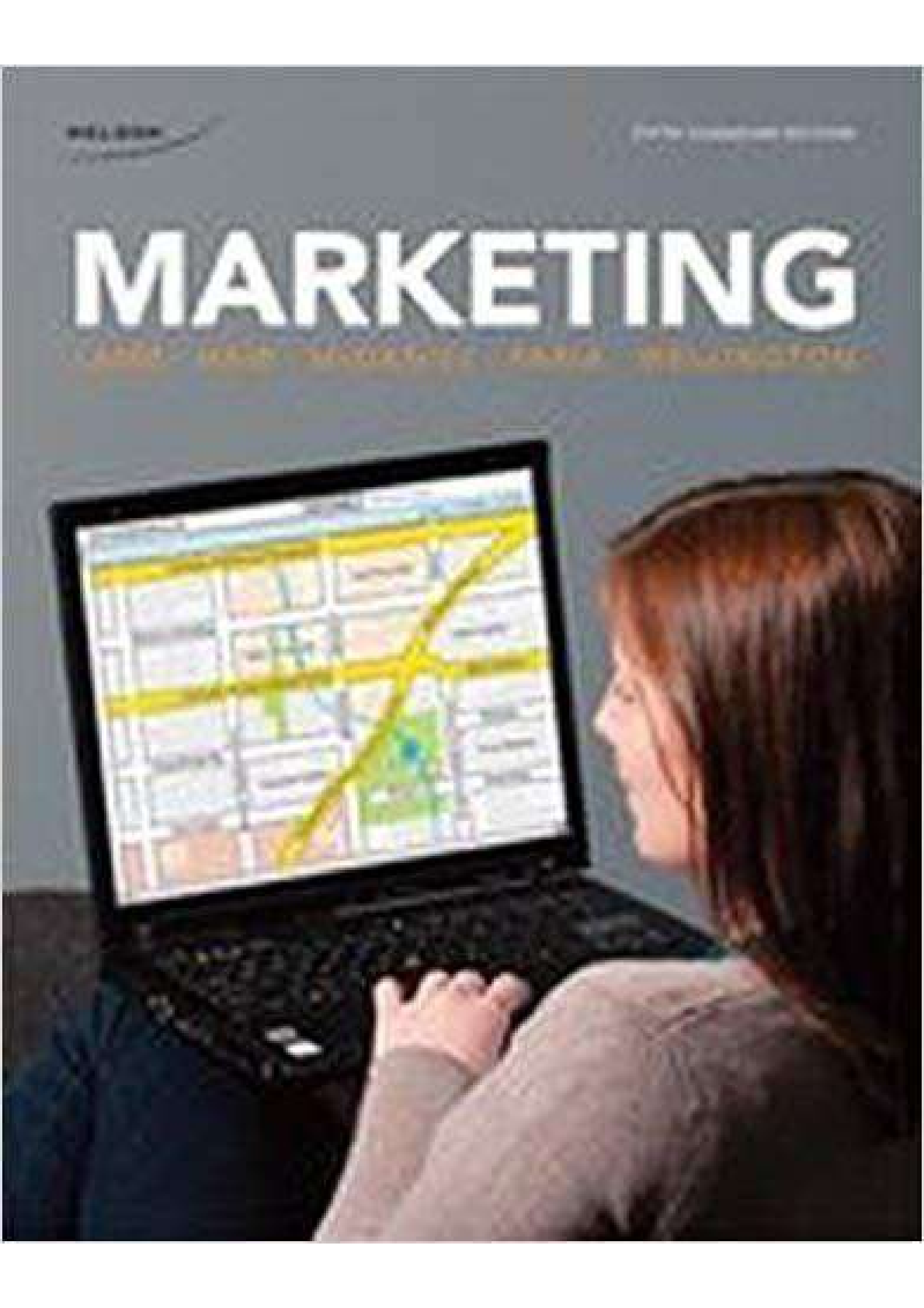Micro Biology > TEST BANK > Microbiology final ocx TEST BANK | contains over 400 (GRADED A) Questions and Answers/ (Bacteria, Th (All)
Microbiology final ocx TEST BANK | contains over 400 (GRADED A) Questions and Answers/ (Bacteria, The American) | Download To Score An A.
Document Content and Description Below
Unformatted text preview: CH-01Answer Key 1. Microorganisms are best defined as organisms that A. can only be found growing in laboratories. B. are too small to be seen with the unaided eye. C. are in... fectious particles. D. lack a cell nucleus. E. cause human disease. 2. Which of the following are not considered microorganisms? A. B. C. D. Fungi Protozoa Viruses Bacteria E.Mosquitoes 3. Helminths are ______. A. molds B.parasitic worms C. bacteria D. protozoa E. infectious particles 4. Among the types of microorganisms, the ______ are noncellular. A. protozoans B. bacteria C.viruses D. helminths *The replication cycles of viruses (lytic and lysogenic) differ among viruses and are determined by their unique structures and genomes. 5. Studies of the immune response to an infection caused by microorganisms would be performed by a(n) ______. A. hypersensitivity specialist B.immunologist C. geomicrobiologist D. epidemiologist Microorganisms, cellular and viral, can interact with both human and nonhuman hosts in beneficial, neutral or detrimental ways. 6. Which of the following pairs of career descriptions and work tasks is not correctly matched? A. Medical microbiologist -- identify the cause of a bladder infection at a hospital lab B. Industrial microbiologist -- manipulate bacterial strains to be less pathogenic C. Agricultural microbiologist -- identify bacterial causes of crop disease D. Public health microbiologist -- track the incidence of AIDS in a population Humans utilize and harness microorganisms and their products. 7. A scientist who studies the influence of microbes in the formation of caves is called a(n) ______. A. astrobiologist B. epidemiologist C. geomicrobiologist D. immunologist Microbes are essential for life as we know it and the processes that support life (e.g., in biogeochemical cycles and plant and/or animal microflora). 8. Astrobiology is considered a sub-discipline of microbiology because A. life elsewhere in the universe is likely to be microbial. B. microbes are known to exist on other planets. C. all extraterrestrials known are microbial. D. only microbes can reproduce under the extreme conditions in outer space. Microorganisms are ubiquitous and live in diverse and dynamic ecosystems. 9. Which of the following does not indicate microbe involvement in energy and nutrient flow? A. Decomposition of dead matter and wastes B. Digestion of complex carbohydrates in animal diets C. Formation of greenhouse gases, CO2 and methane D. Thermal hot springs warmed by heat from earth's interior Microorganisms are ubiquitous and live in diverse and dynamic ecosystems. 10. The microorganisms that recycle nutrients by breaking down dead matter and wastes are called ______. A. B. C. D. E. fermenters eukaryotes decomposers pathogens prokaryotes Bacteria and Archaea exhibit extensive, and often unique, metabolic diversity (e.g., nitrogen fixation, methane production, anoxygenic photosynthesis). Microbes are essential for life as we know it and the processes that support life (e.g., in biogeochemical cycles and plant and/or animal microflora). 11. The majority of oxygen in earth's atmosphere is a product of photosynthesis by ______. A. B. C. D. rain forests microorganisms green plants agricultural lands 12. The three cell types discussed, eukaryotes, archaea, and bacteria, all derived from ______. A. B. C. D. cells with a true nucleus the last universal common ancestor photosynthetic bacteria archaea 13. The first cells appeared about ___ billion years ago. A. B. C. D. E. 5 4.5 3.5 2 1 14. A hypothesis must be tested many times before it can be considered a theory. TRUE Ability to apply the process of science: Demonstrate an ability to formulate hypotheses and design experiments based on the scientific method. 15. Which area of biology states that living things undergo gradual structural and functional changes over long periods of time? A. B. C. D. E. Evolution Morphology Phylogeny Genetics Transformation The evolutionary relatedness of organisms is best reflected in phylogenetic trees. 16. When humans manipulate the genes of microorganisms, the process is called ______. A. B. C. D. E. epidemiology taxonomy bioremediation genetic engineering immunology Cell genomes can be manipulated to alter cell function. Humans utilize and harness microorganisms and their products. 17. Which activity is an example of biotechnology? A. B. C. D. E. Bacteria in the soil secreting an antibiotic to kill competitors Public health officials monitoring diseases in a community Egyptians using moldy bread on wounds A microbiologist using the microscope to view bacteria Escherichia coli producing human insulin 18. Which of the following is a traditional human use of microorganisms? A. B. C. D. Baking bread Cleaning up oil spills Treating water and sewage Mass-producing antibiotics 19. Using microbes to detoxify a site contaminated with heavy metals is an example of ______. A. B. C. D. E. biotechnology bioremediation decomposition epidemiology immunology 20. Disease-causing microorganisms are called ______. A. B. C. D. E. pathogens decomposers fermenters bacteria eukaryotes 21. The number one worldwide infectious diseases are ______. A. B. C. D. E. AIDS-related diseases malaria and other protozoan diseases respiratory diseases measles and other rash diseases diarrheal diseases 22. Many chronic medical conditions have been found to be associated with microbial agents. TRUE 23. The incidence of deaths from communicable disease is ______ in the United States compared to the entire world. A. less B. greater C. about the same 24. In which way are bacteria and eukaryotes the same? A. B. C. D. Contain a nucleus to hold DNA Contain ribosomes for protein synthesis Contain membrane-bound organelles Have a cell wall for rigidity 25. In which way are archaea and eukaryotes the same? A. B. C. D. Have a cell wall for rigidity Can use flagella for movement Contain mitochondria for energy production Contain membrane-bound organelles 26. All bacteria and archaea are microorganisms, but only some eukaryotes are microorganisms. TRUE 27. Which of the following is a unique characteristic of viruses that distinguishes them from the other major groups of microorganisms? A. Cannot be seen without a microscope B. Contain genetic material C. Cause human disease D. Lack a nucleus E. Lack cell structure 28. Organisms called parasites are ______. A. B. C. D. the decomposers in ecosystems always viruses always harmful to their host free-living 29. Which group of microorganisms is composed only of hereditary material wrapped in a protein covering? A. B. C. D. E. Yeasts Parasites Viruses Fungi Bacteria 30. Eukaryotic cells are larger than bacterial or archaeal cells; all cells are larger than macromolecules. Where do viruses fit on this scale? A. B. C. D. Viruses are smaller than eukaryotic cells, but larger than bacterial or archaeal cells. Viruses are smaller than macromolecules. Viruses are larger than eukaryotic cells. Viruses are smaller than bacterial or archaeal cells, but larger than macromolecules. 31. In general, eukaryotic cells are about ______ times larger than bacterial or archaeal cells. A. B. C. D. 2 10 50 1000 32. Archaeal cells are about ______ bacterial cells. A. ten times smaller than B. the same size as C. ten times larger than 33. Many chronic infections are caused by microbes that associate in communities termed ______. A. B. C. D. biofilms virions microbiota sediments 34. Which of the following historical microbiologists is incorrectly paired with his contribution to the science? A. B. C. D. Francesco Redi: tested spontaneous generation with meat exposed to the air or covered with cloth Louis Pasteur: demonstrated that anthrax was caused by a bacterium Joseph Lister: promoted disinfecting hands and air prior to surgery Antonie van Leeuwenhoek: made and used quality magnifying lenses to observe and record microorganisms 35. In the experiments constructed by Pasteur to disprove spontaneous generation, swan-necked flasks were used. Why was this shape of flask used in this experiment? A. The shape of the glass neck allowed the bacteria into the flask and then into the media, but air could not enter. B. The glass necks needed to be open to the air, yet constructed so that bacteria would settle in the lowest part of the neck. C. These flask shapes were the easiest and cheapest to produce. D. Because the glass necks were stretched out, the heat used to sterilize the medium inside of the flask could not kill the bacteria in the neck. 36. Koch's postulates are criteria used to establish that A. B. C. D. E. microbes are found on dust particles. a specific microbe should be classified in a specific kingdom. microbes can be used to clean up toxic spills. a specific microbe is the cause of a specific disease. life forms can only arise from preexisting life forms. 37. Which of the following is NOT a recent discovery that has had a huge impact on the understanding of microbiology? A. B. C. D. E. Restriction enzymes PCR technique Biofilms Small RNAs All are significant discoveries. 38. The sum total of all the microbes in a certain environment is termed the ______. A. B. C. D. E. microbiome microbial niche domain biofilm phylogeny 39. Which of the following is not a process in the scientific method? A. Systematic observation B. Development of a theory C. Laboratory experimentation D. Formulation of a hypothesis E. Belief in a preconceived idea 40. Experimentation A. B. C. D. E. is the first step in the scientific method. is designed to support an hypothesis. provides a means to gather objective data. is designed to refute an hypothesis. provides a means to gather subjective data. 41. The scientific method includes all of the following except ______. C. publication A. experimentation D. observation B. hypothesis 42. The scientific method involves formulating a tentative explanation, called the hypothesis, to account for what has been observed or measured. TRUE 43. Caring for patients infected with a new virus requires safety precautions for medical personnel. Choosing appropriate procedures is an example of a(n) ______ process. A. B. C. D. pathogenic deductive hypothetical inductive 44. Sterile refers to ______. A. B. C. D. E. homogenized absence of any life forms and viral particles pathogen-free pasteurized absence of spores lo 45. Taxonomy does not involve ______. A. B. C. D. classification a common name nomenclature identification 46. Which scientific field is involved in the identification, classification, and naming of organisms? A. B. C. D. E. Nomenclature Epidemiology Taxonomy Phylogeny Pathology 47. The orderly arrangement of organisms into a hierarchy of taxa is called ______. A. B. C. D. E. experimentation biotechnology classification identification nomenclature 48. Members of the same species share many more characteristics compared to those shared by members of the same kingdom. TRUE 49. Which of the following is a taxon that contains all the other taxa listed? A. Family B. Genus C. Kingdom D. Species E. Phylum 50. The smallest and most significant taxon is a ______. A. B. C. D. E. kingdom phylum species family genus 51. Select the correct descending taxonomic hierarchy (left to right). A. B. C. D. E. Class, phylum, order Family, genus, species Kingdom, domain, phylum Family, order, class Genus, species, family 52. A recently-developed mnemonic for remembering the taxonomic levels from Domain to Species is "Dumb Kids Prefer Candy Over Fancy Green Salad." The word "candy" here is a reminder of the taxonomic level of _______. A. B. C. D. E. chain culture category colony class 53. Which of the following is a scientific name? A. B. C. D. Streptobacilli Gram-positive streptococcus Anthrax Streptococcus pyogenes 54. When assigning a scientific name to an organism, A. B. C. D. E. the species name is placed first. the species name can be abbreviated. both genus and species names are italicized or underlined. both genus and species names are capitalized. the species name is capitalized. 55. Which scientific name is written correctly? A. B. C. D. E. S. aureus Staphylococcus aureus Staphylococcus Aureus staphylococcus aureus Staphylococcus aureus 56. The names of the three proposed domains are: Bacteria, Protista, and Eukarya. FALSE 57. A diagram of the three domains (Bacteria, Archaea, Eukarya) proceeding from the Last Universal Common Ancestor would show Archaea A. branching off the Domain Bacteria. B. branching off the Domain Eukarya. C. as the original cells from which the others derived. 58. Analysis of the small subunit rRNAs from all organisms in the three current domains suggests that A. B. C. D. the prokarytoes, archaea, and eukaryotes are not related. the eukaryotes arose from prokaryotes. the Archaea are more closely related to bacteria than eukaryotes. all modern and extinct organisms on earth arose from a common ancestor. 59. The study of evolutionary relationships among organisms is called ______. A. B. C. D. E. genetics biotechnology phylogeny taxonomy recombinant DNA 60. A scientist studying the sequence of nucleotides in the rRNA of a bacterial species is working on A. B. C. D. E. recombinant DNA. nomenclature. determining evolutionary relatedness. bioremediation. determining if that species is the cause of a new disease. 61. Trees of life that illustrate the phylogenetic relationships of all organisms were traditionally based on ______; newer methods for determining phylogeny rely on ______. A. morphology; virology B. nucleic acid sequences; morphology C. morphology; nucleic acid sequences D. nucleic acid sequences; microbiomes E,morphology; nutritional requirements CH-02: 1. An atom has gained an electron; it has been ______. A. ionized B. oxidized C. neutralized D. reduced E. deionized 1. Anything that occupies space and has mass is called ______. A. matter B. energy C. living D. space E. atomic 2. The electrons of an atom are A. moving in pathways called orbitals. B. used to determine atomic number. C. positively charged. D. always equal to the number of neutrons in an atom. E. found in the nucleus. 3. The electrons of an atom are A. used to determine the atomic weight. B. always equal to the number of protons. C. carrying a positive charge. D. always in full orbitals. E. used to determine the atomic number. 4. All of the following pertain to the atom Carbon-14 except it A. has 14 neutrons. B. is an isotope of carbon. C. has 6 protons. D. has 6 electrons. 5. The subatomic particles that surround the nucleus are the ______. protons and neutrons B. neutrons C. electrons D. protons E. protons and electrons A. B. 6. What is the maximum number of electrons in the second energy shell of an atom? A. 2 B. 4 C. 8 D. 18 E. 32 7. What is the maximum number of electrons in the first energy shell of an atom? A. 2 B. 4 C. 8 D. 18 E. 32 8. Protons and neutrons make up the atom's central core, which is referred to as its ______. A. isotope B. center of gravity C. valence number D. nucleus 9. The valence number is the A. number of protons. B. atomic weight. C. number of neutrons. D. number of electrons in the innermost orbital. E. number of electrons in the outermost orbital. 10. Two or more atoms bonded together are called a(n) ______. A. molecule B. isotope C. ion D. electrolyte E. element 11. What would be the valence number of electrons in the sulfur (S) atom? Its atomic number is 16. A. 2 B. 6 C. 8 D. 16 E. 32 12. Polar molecules A. always contain carbon. B. have an equal charge distribution. C. have an unequal charge distribution. D. always involve oxygen. E. are insoluble in water. 13. Organic chemicals always have a basic framework of the element _____ bonded to other atoms. A. oxygen B. phosphorous C. nitrogen D. hydrogen E. carbon 14. C6H12O6 + C6H12O6 C12 H22O11 + H2O represents A. the formation of a polysaccharide. B. the formation of a peptide bond. C. a decomposition reaction. D. a denaturation reaction. E. a dehydration synthesis. 15. Electrons that participate in chemical bonding are typically located closest to the nucleus. FALSE 16. Substances that release ions when dissolved in water and conduct electricity are ______. A. covalent B. solvents C. nonpolar D. electrons E. electrolytes 16. A capillary tube is used to acquire a small blood sample for CBC (complete blood count) analysis. Suction is not required to transfer the blood from the fingertip prick to the tube in part due to A. covalent bonding between the water molecules. B. cohesive forces between the glass particles of the tube and the water molecules. C. ionic bonding between the water molecules. D. adhesive forces between the water molecules and the glass particles of the tube. 17. Polar molecules are composed of covalently bonded A. carbon atoms. B. ions. C. identical atoms. D. atoms of identical electronegativity. E. atoms of different electronegativity. 18. Covalent bonds A. result from gaining electrons. B. are always nonpolar. C. result from losing electrons. D. are always polar. E. result from sharing electrons. 19. Cations are A. atoms without protons. B. charged subatomic particles. C. atoms that have gained electrons. D. capable of forming ionic bonds with anions. E. atoms that have gained neutrons. 20. A reaction where an electron is lost is called ______. A. oxidation B. reduction C. ionization D. decomposition E. dissolution 21. Ionic bonds A. result from like charge attraction. B. result from transferring electrons. C. are the weakest chemical bonds. D. always involve carbon. E. result from sharing electrons. 22. Hydrogen bonds A. result from attractive forces between molecules with polar covalent bonds. B. are the strongest bonds between molecules. C. result from attractive forces between molecules with polar ionic bonds. D. result from attractive forces between molecules with nonpolar ionic bonds. E. result from attractive forces between molecules with nonpolar covalent bonds. 23. Atoms that gain or lose electrons become charged particles called ______. A. ions B. isotopes C. anions D. cations 24. Which of the following represents a synthesis reaction? A. AB A + B B. A + B AB C. AB + XY AY + XB D. AB + XY AY + XB 25. Which of the following represents a reversible reaction? A. A + B AB B. AB A + B C. AB + XY AY + XB D. AB + XY AY + XB 26. Ionic compounds A. are basic in solution. B. are acidic in solution. C. are hydrophobic. D. are hydrophilic. E. always form salts in solution. 27. Water molecules are nonpolar molecules. FALSE 28. Polar molecules have more reactivity compared to nonpolar molecules. TRUE 29. A covalent bond is formed between an anion and a cation. FALSE 30. The important solvent associated with living things is ______. A. benzene B. sodium chloride C. water D. carbon dioxide E. ethyl alcohol 31. The concentration of a solution expresses the amount of solvent present. FALSE 32. In the cell cytoplasm, molecules of ATP are a ______. A. solute B. solvent 33. Burning coal produces sulfur dioxide in the atmosphere. When combined with rain that falls into bodies of water, this leads to A. a greater concentration of OH- ions in the water. B. a decrease in the pH level of the water. C. an increase in pH level of the water. D. no change in the pH level of the water. 34. Compared to a solution of pH 9, a solution of pH 7 A. is more basic. B. has more H+ ions. C. has a higher pH. D. has no OH- ions. 35. Compared to a solution of pH 9, a solution of pH 7 is A. 20 times more basic. B. 2 times more acidic. C. 100 times more acidic. D. 100 times more basic. E. 20 times more acidic. 36. If solution A has a lower pH compared to solution B, then solution A is more acidic than solution B. TRUE 37. One technique for staining bacteria for viewing under the microscope is called the Gram stain. In this technique, alcohol is used as a decolorizer because it degrades the outer membrane found in some bacteria. What chemical component of the cell does alcohol affect? A. Protein B. Lipid C. Nucleic ac... [Show More]
Last updated: 1 year ago
Preview 1 out of 483 pages

Reviews( 0 )
Document information
Connected school, study & course
About the document
Uploaded On
Oct 06, 2021
Number of pages
483
Written in
Additional information
This document has been written for:
Uploaded
Oct 06, 2021
Downloads
0
Views
54

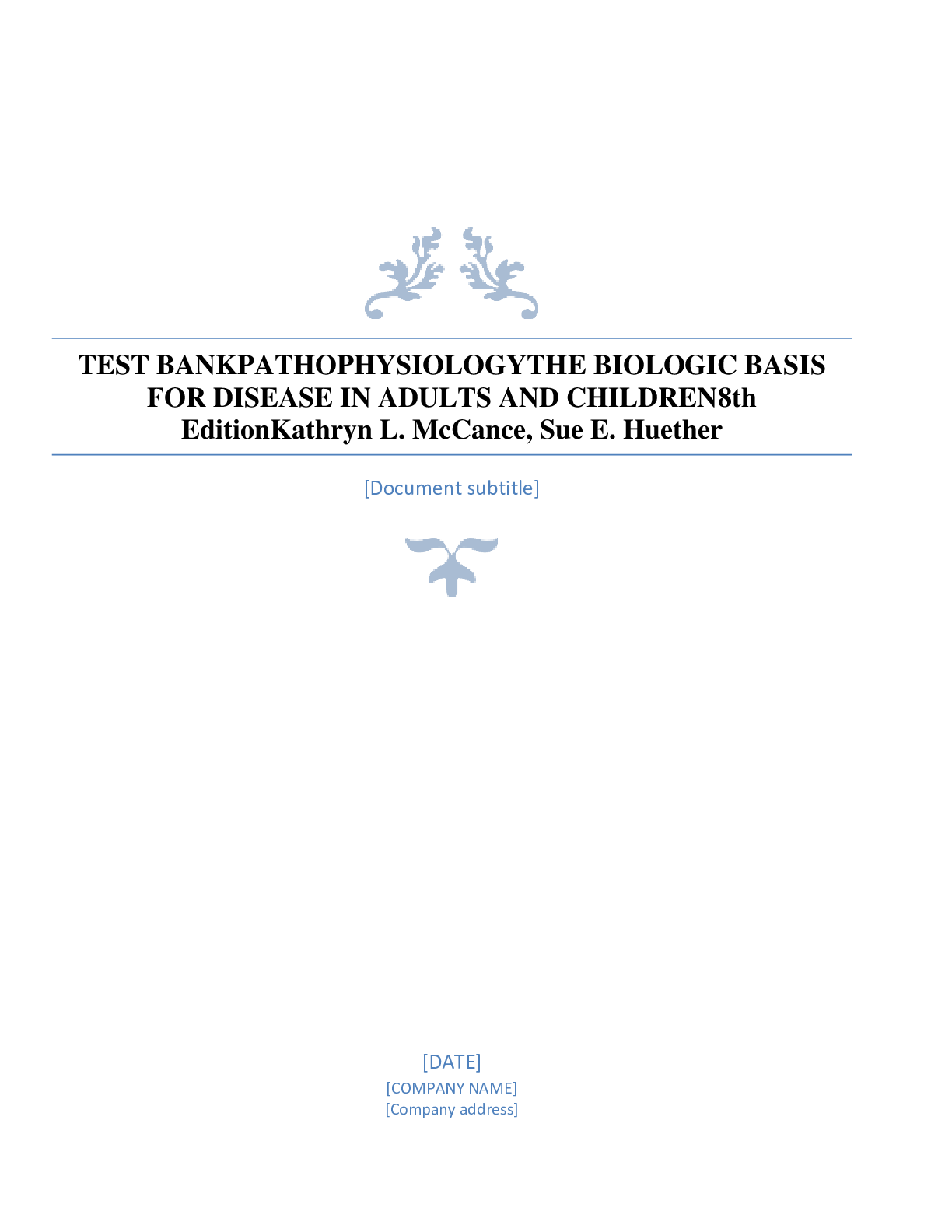


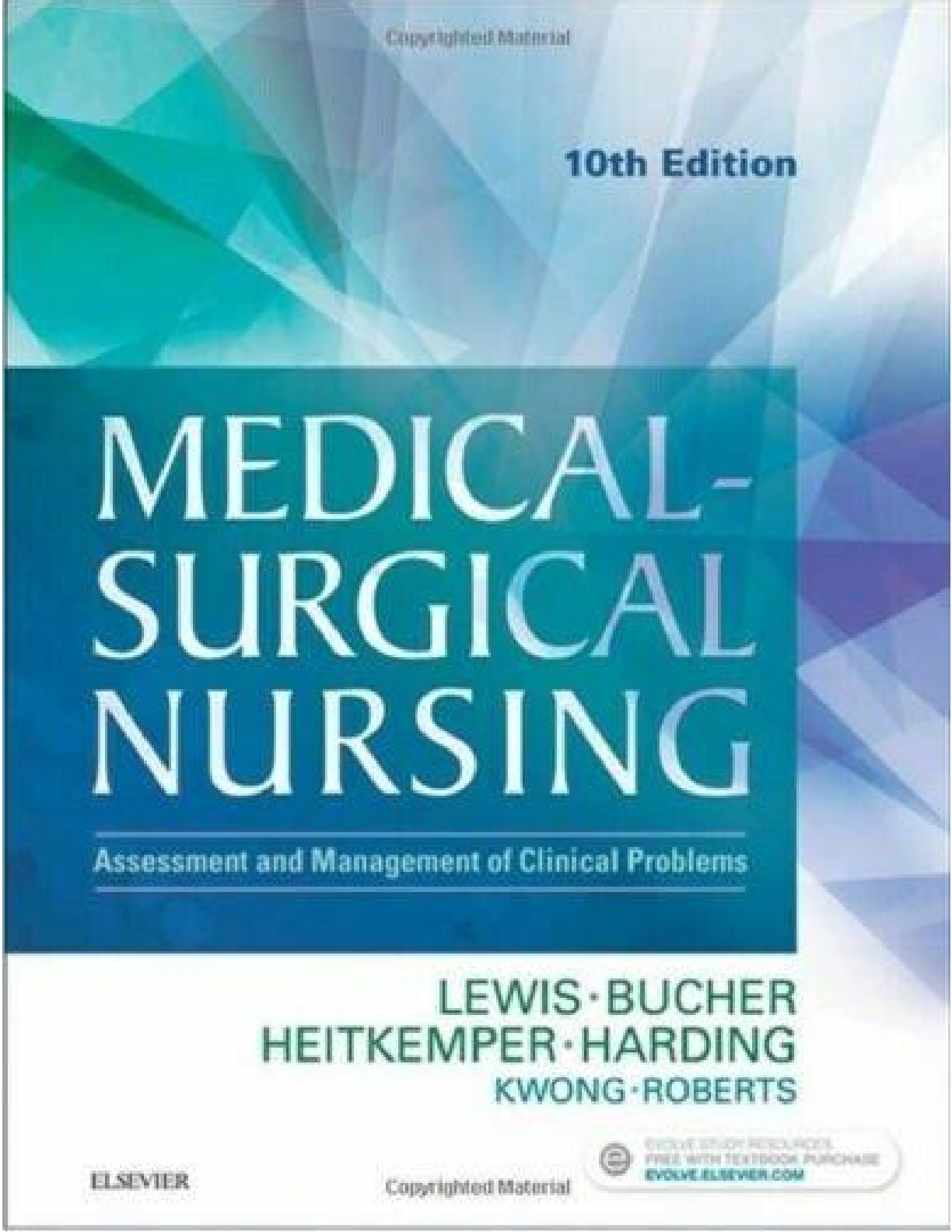
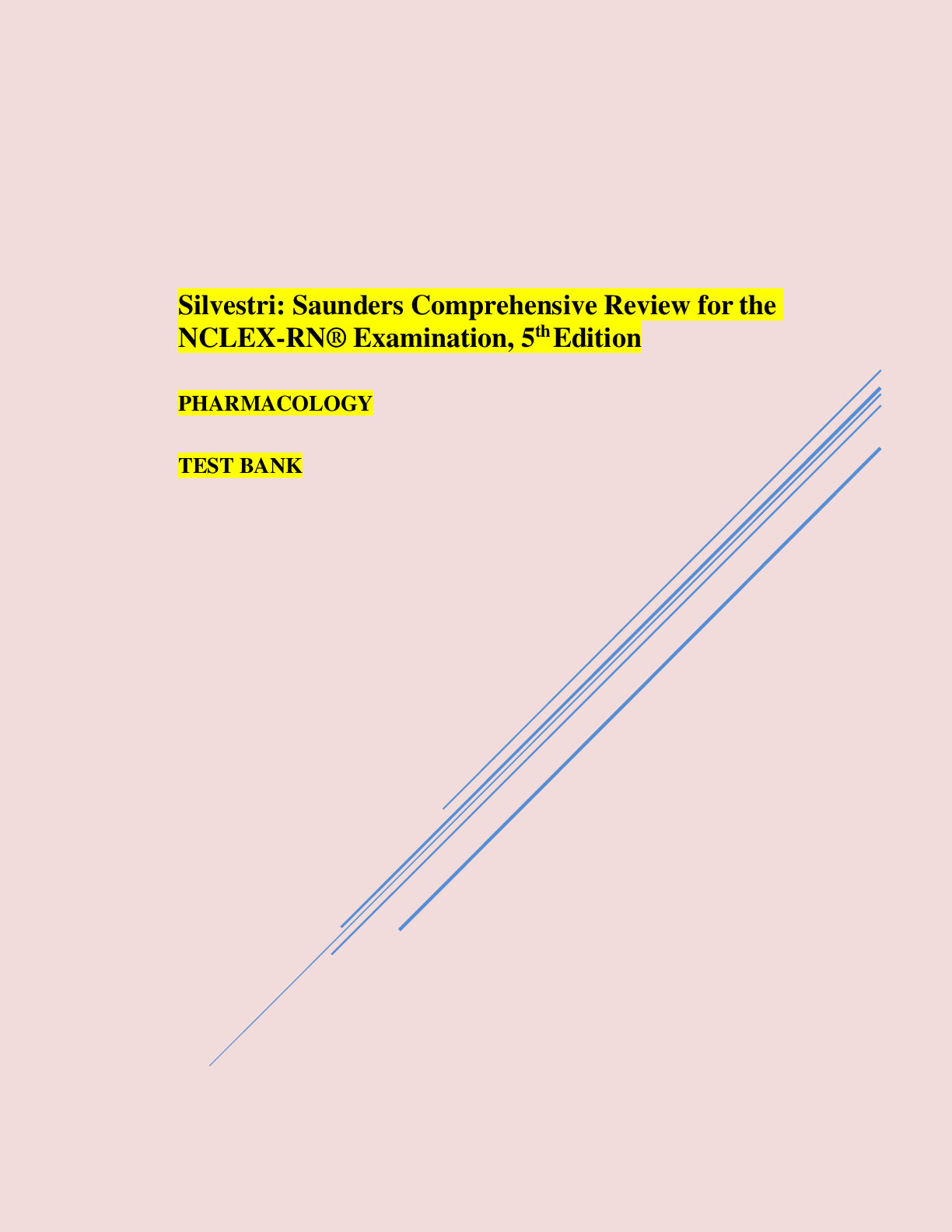

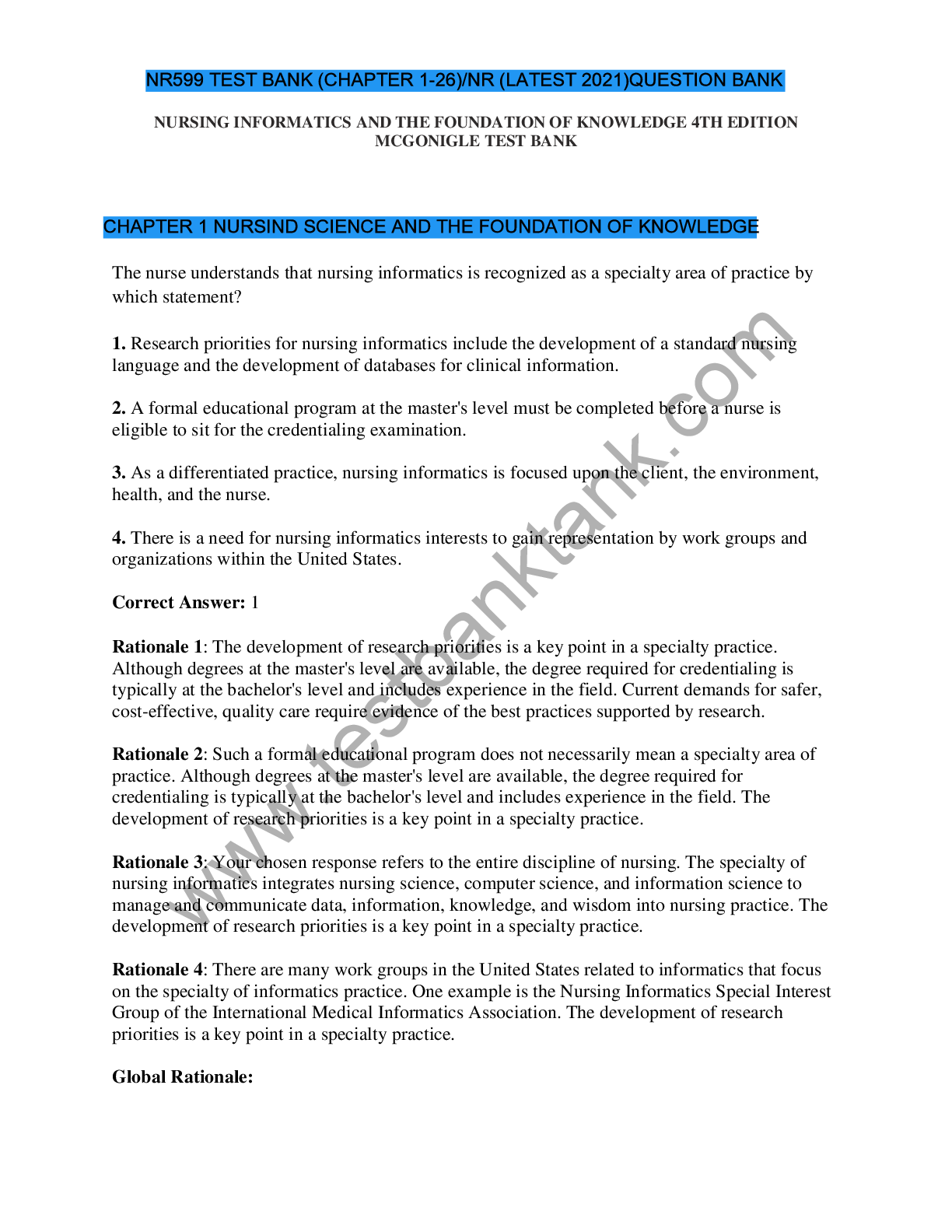
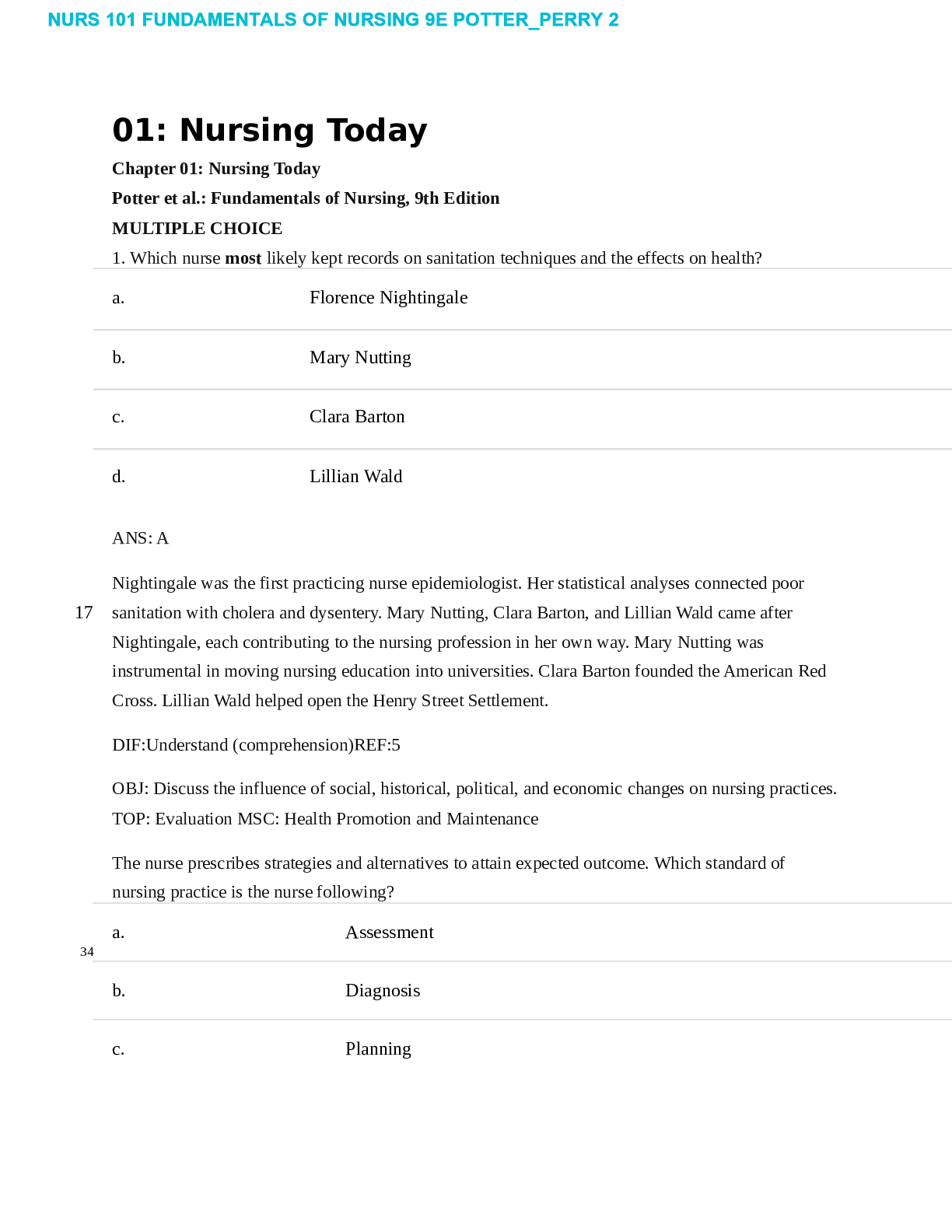

.png)
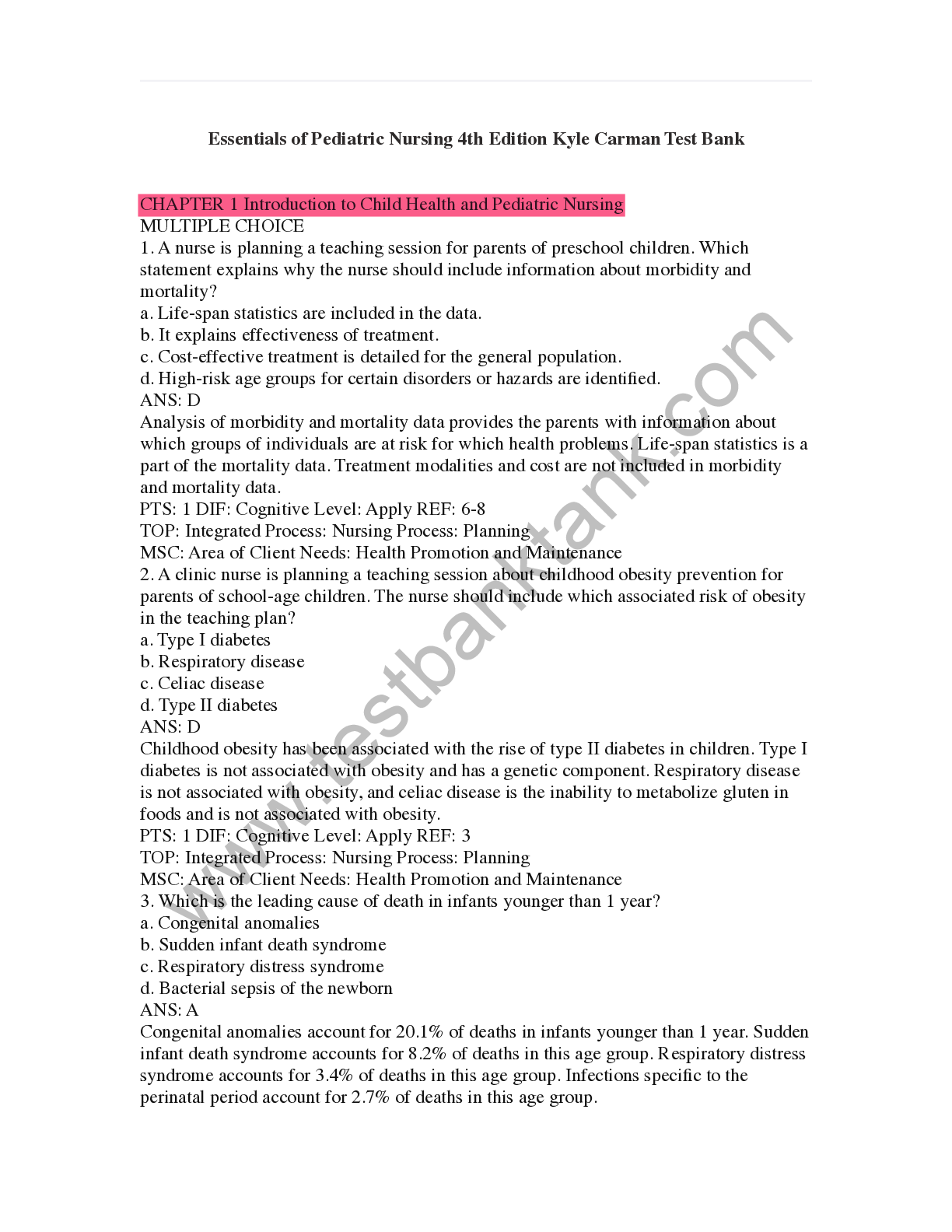
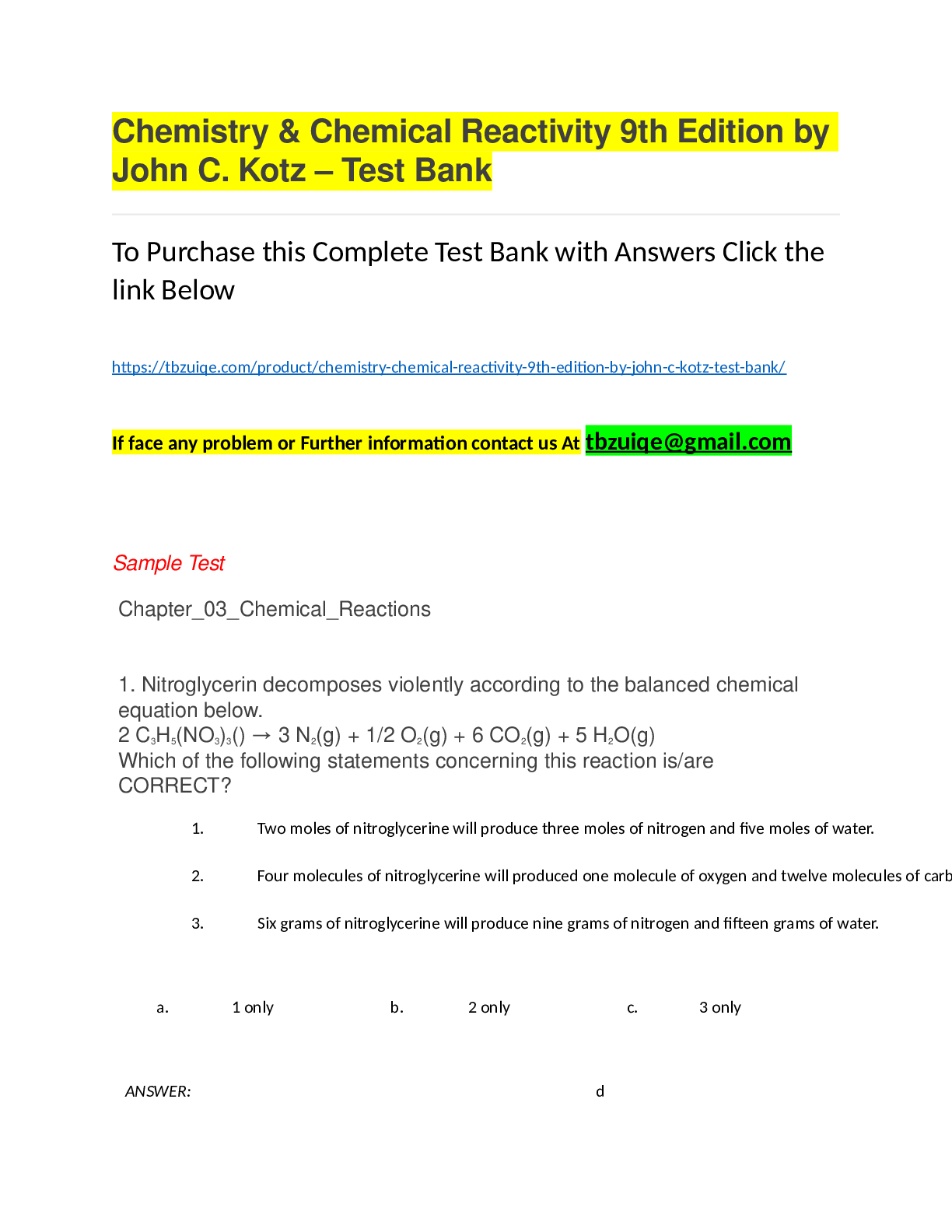
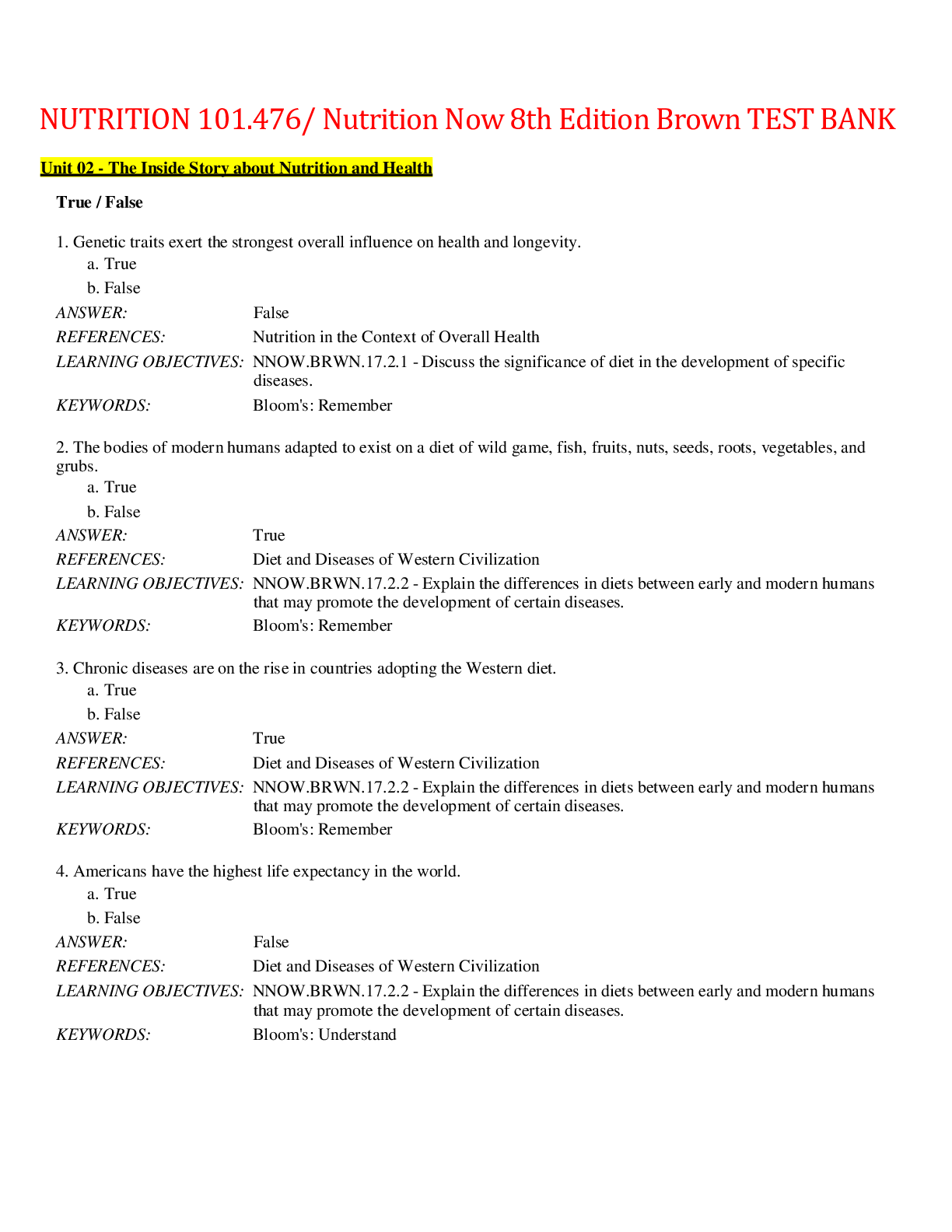
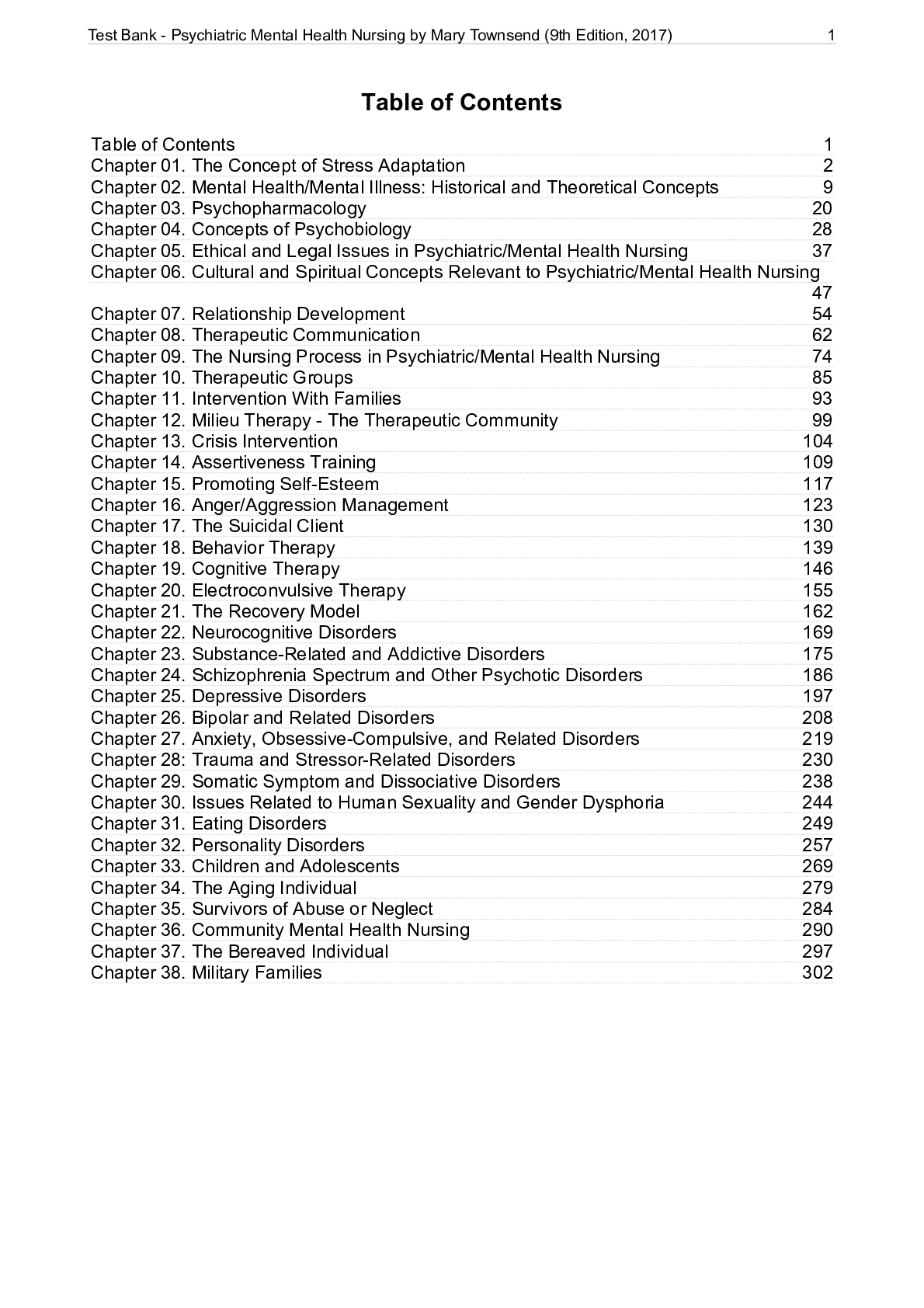

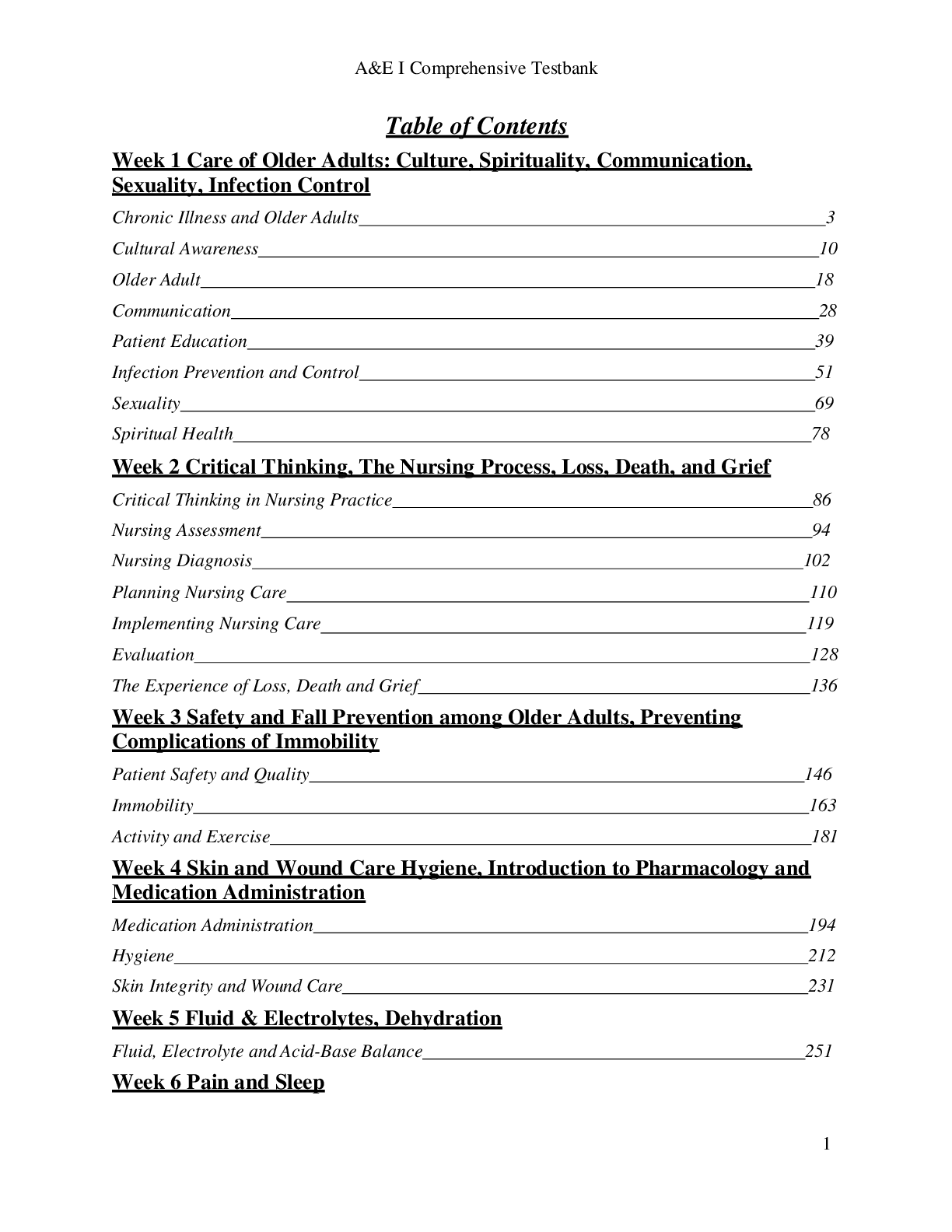
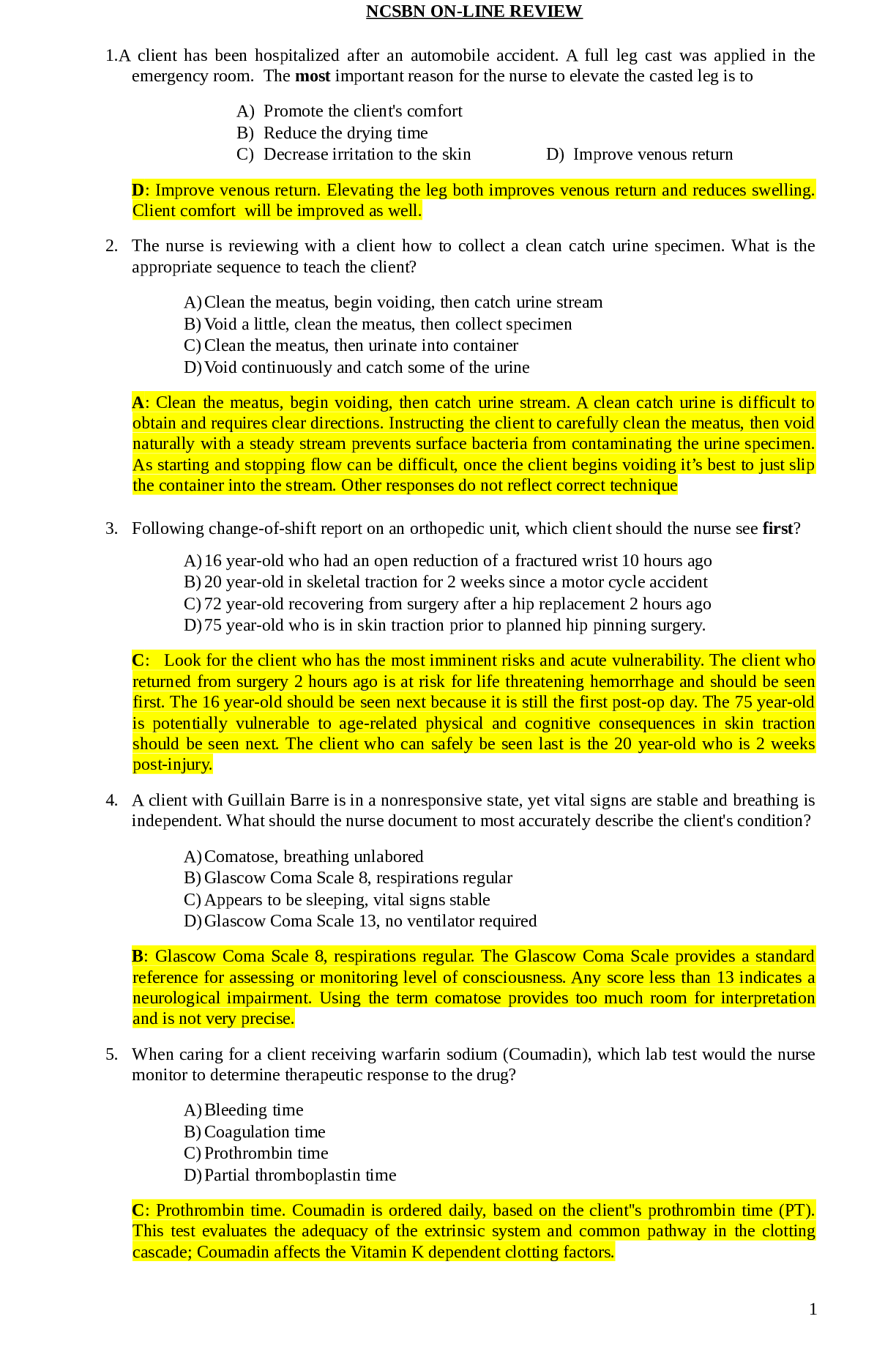
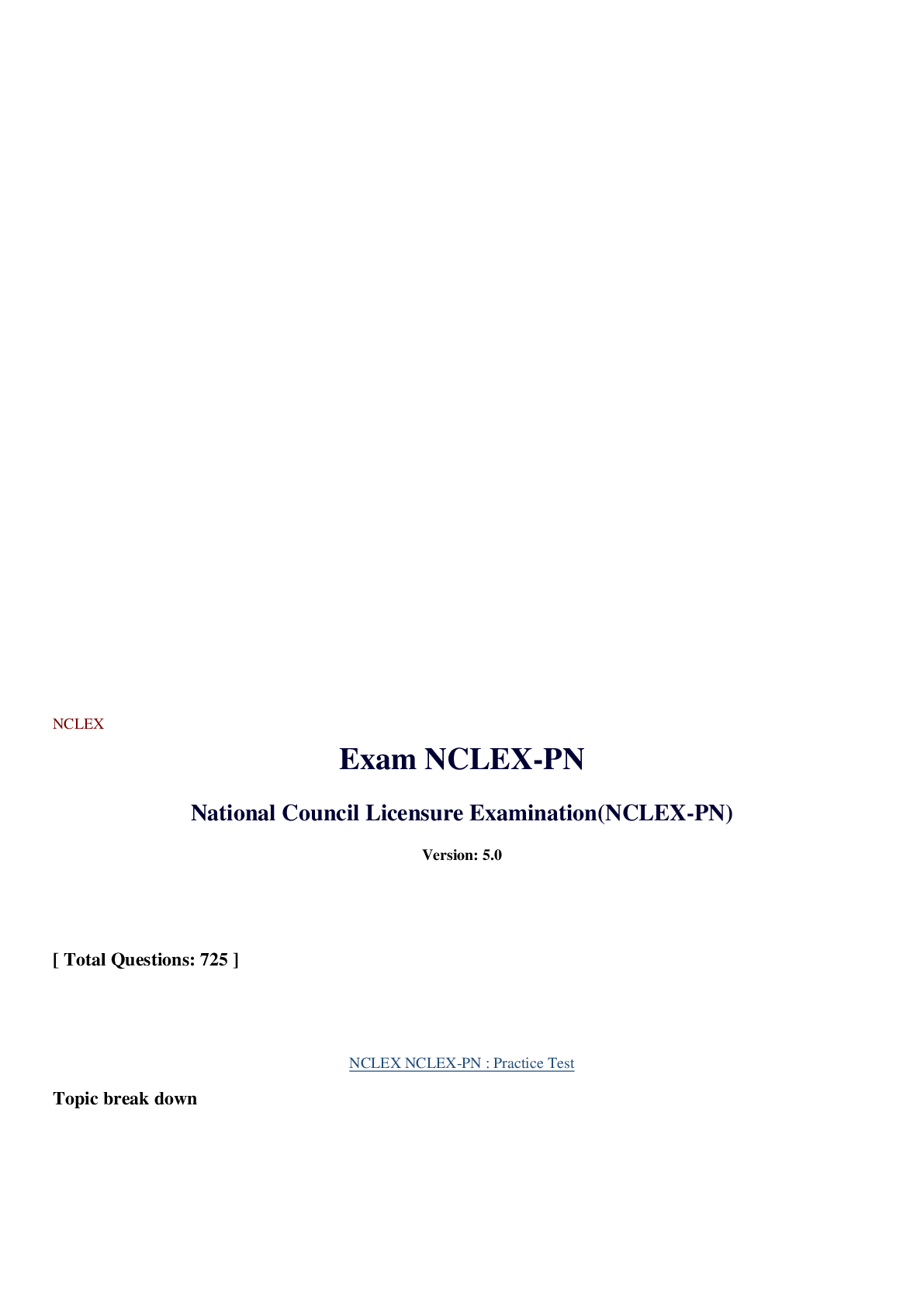
 (1).png)
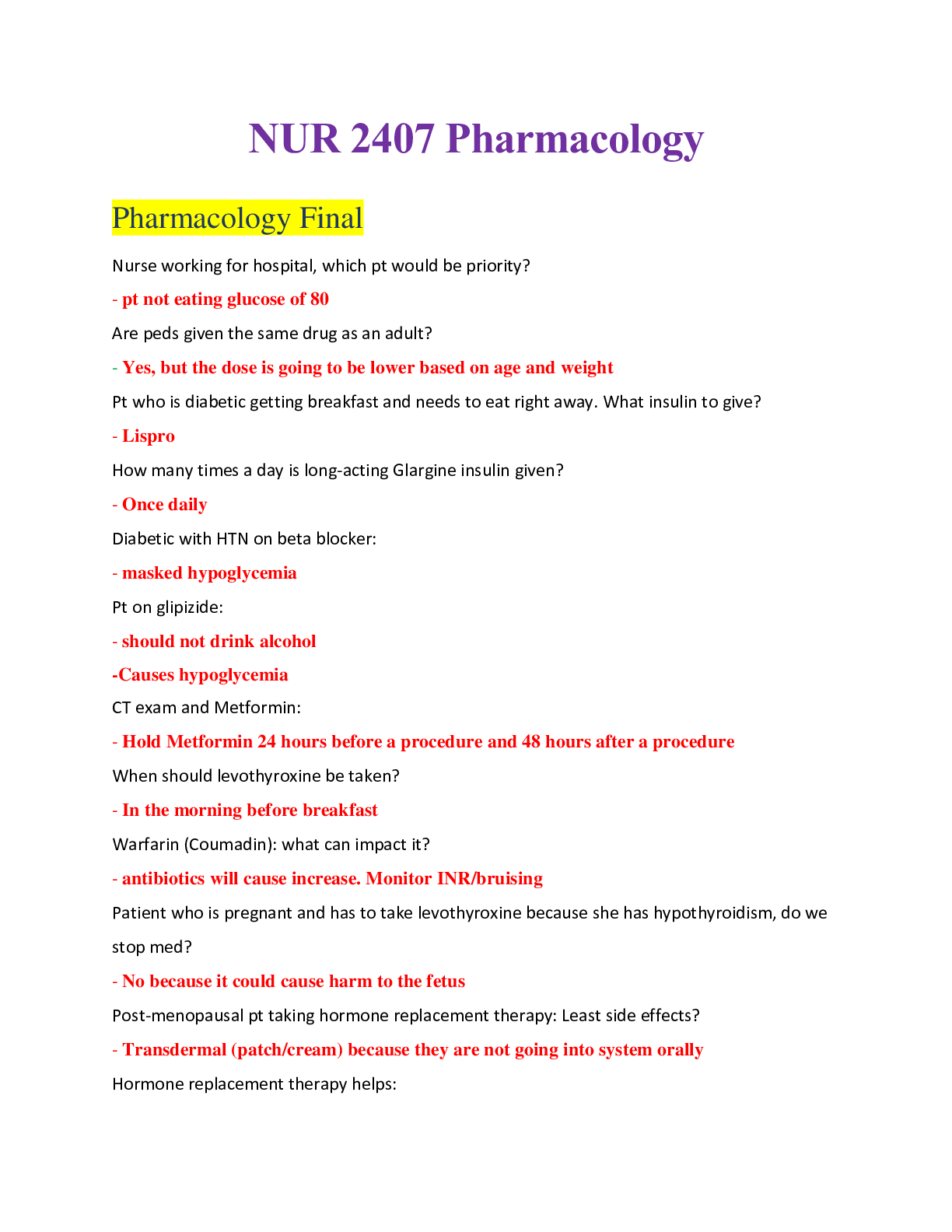
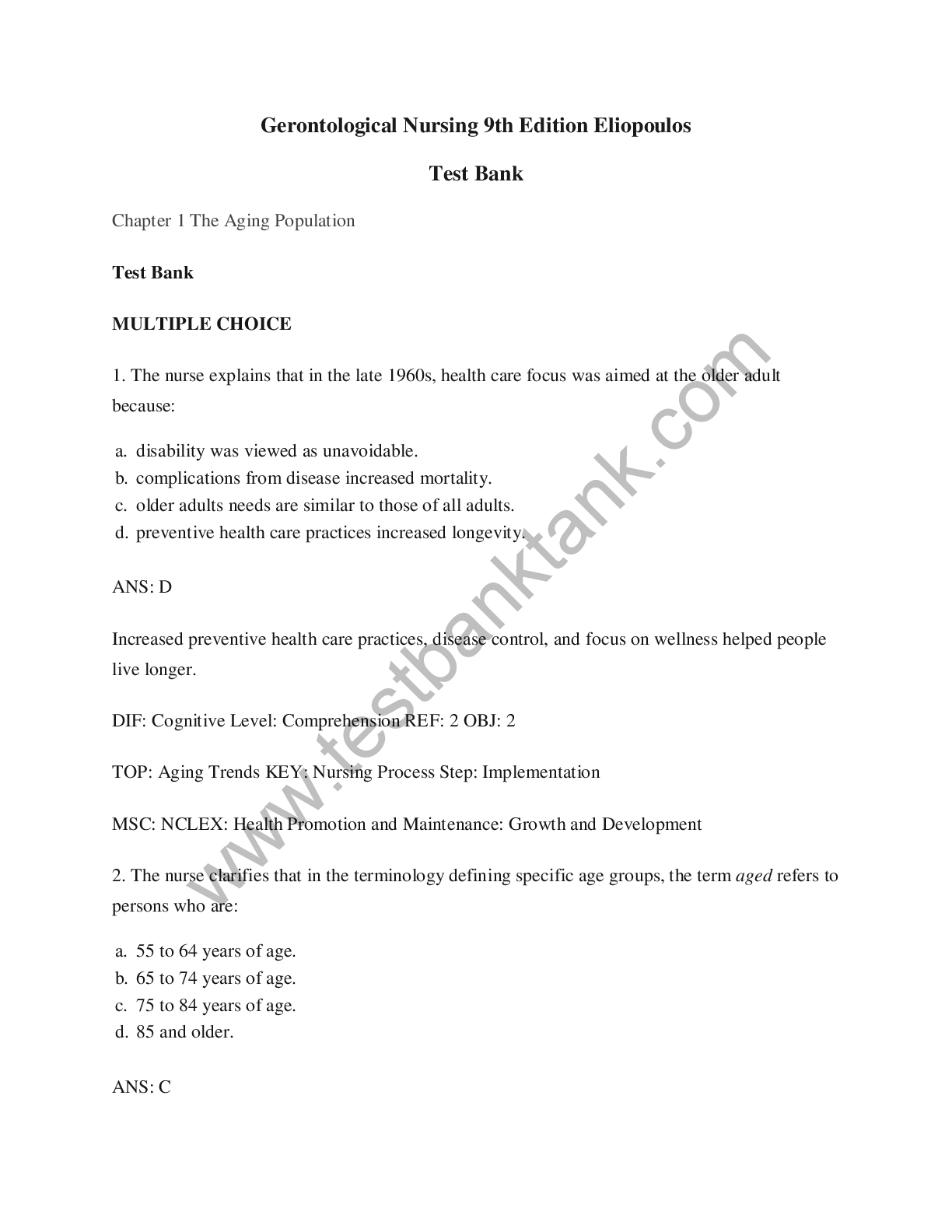
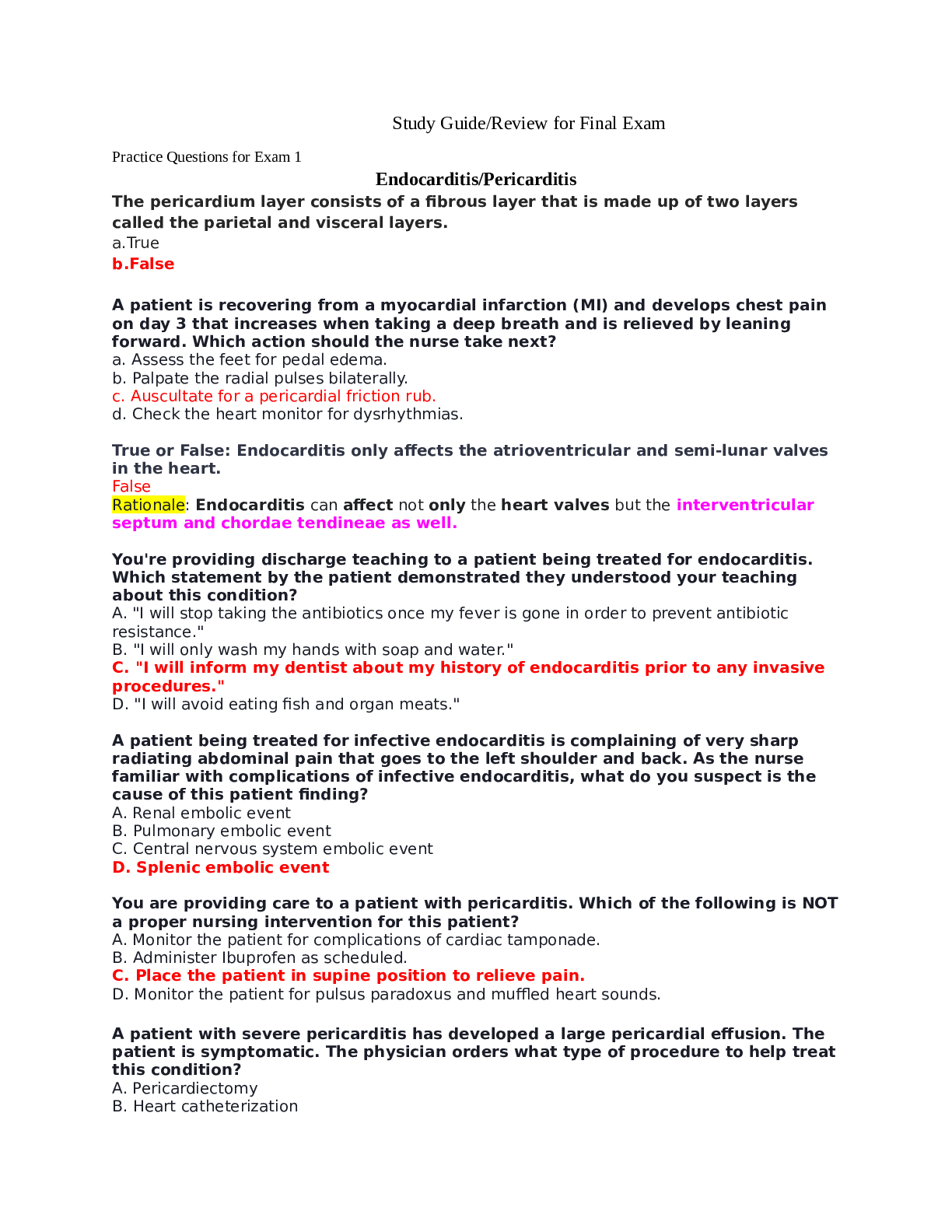
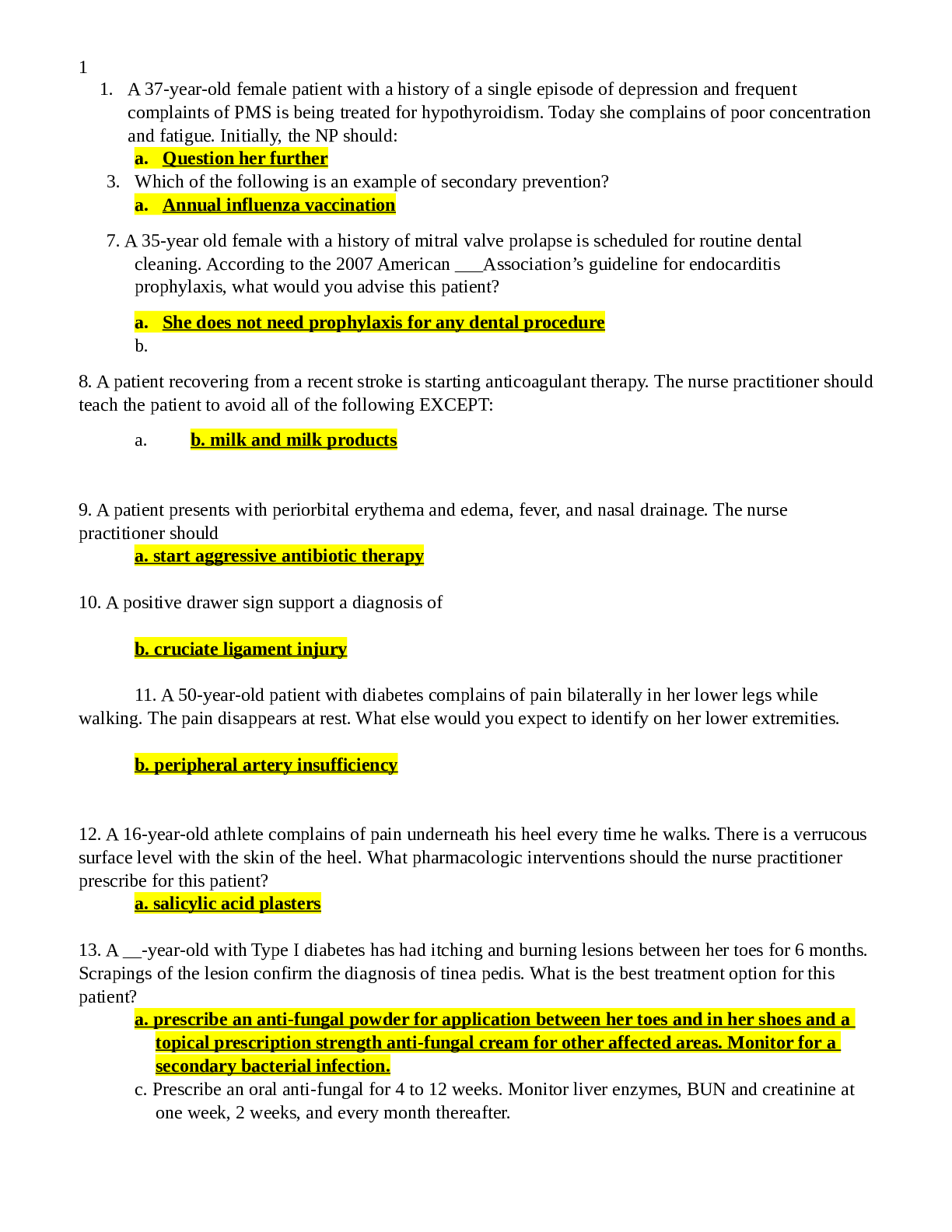

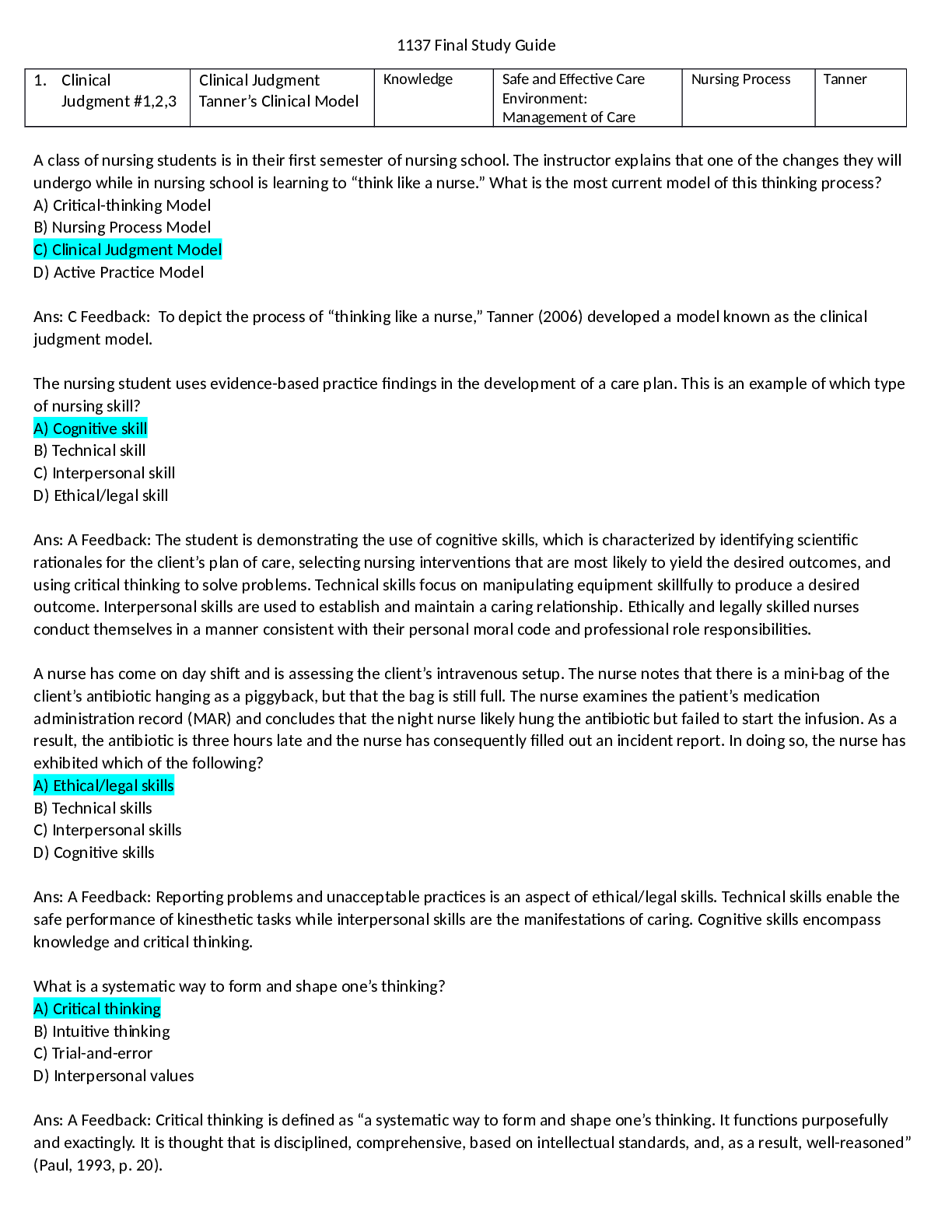

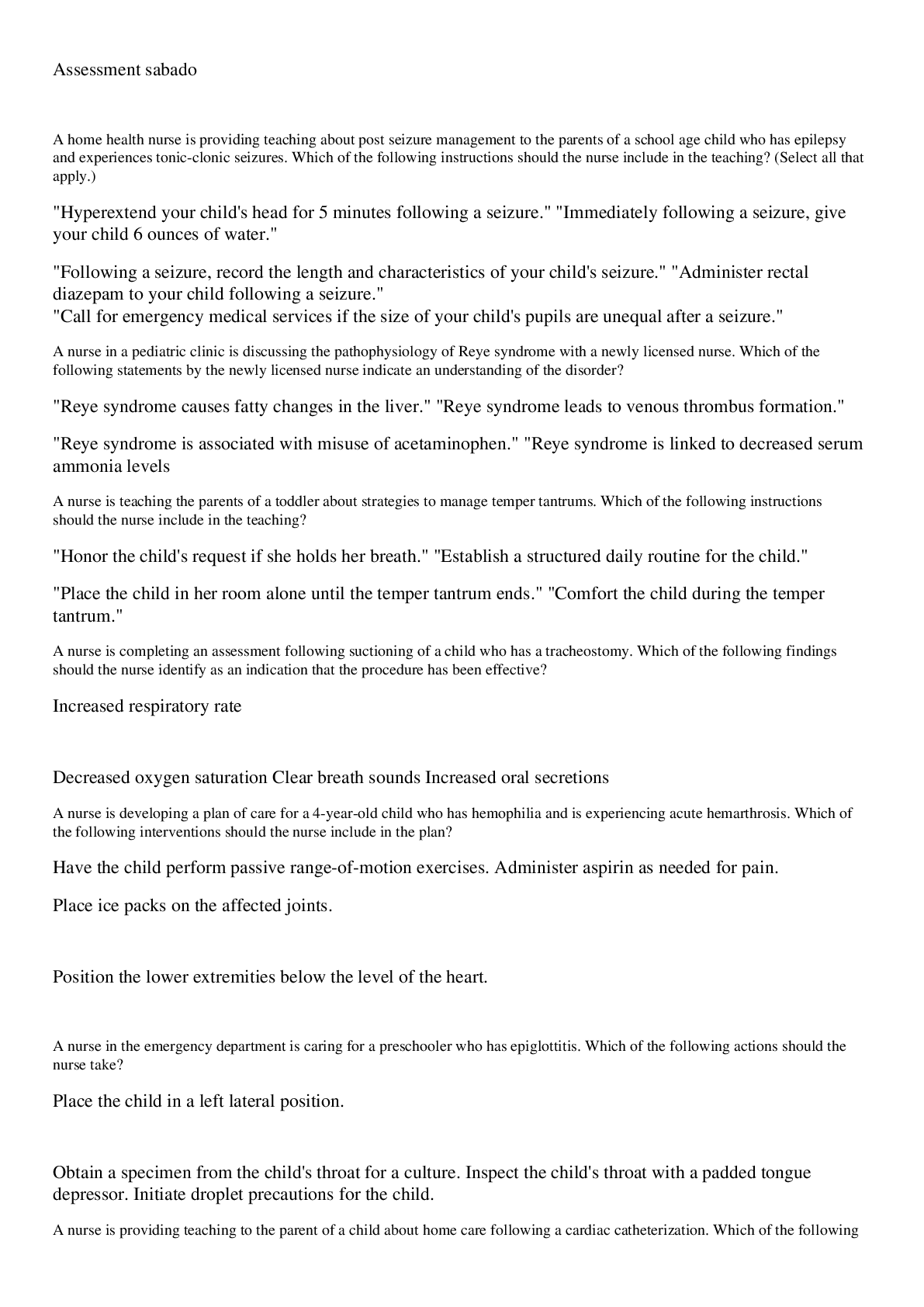
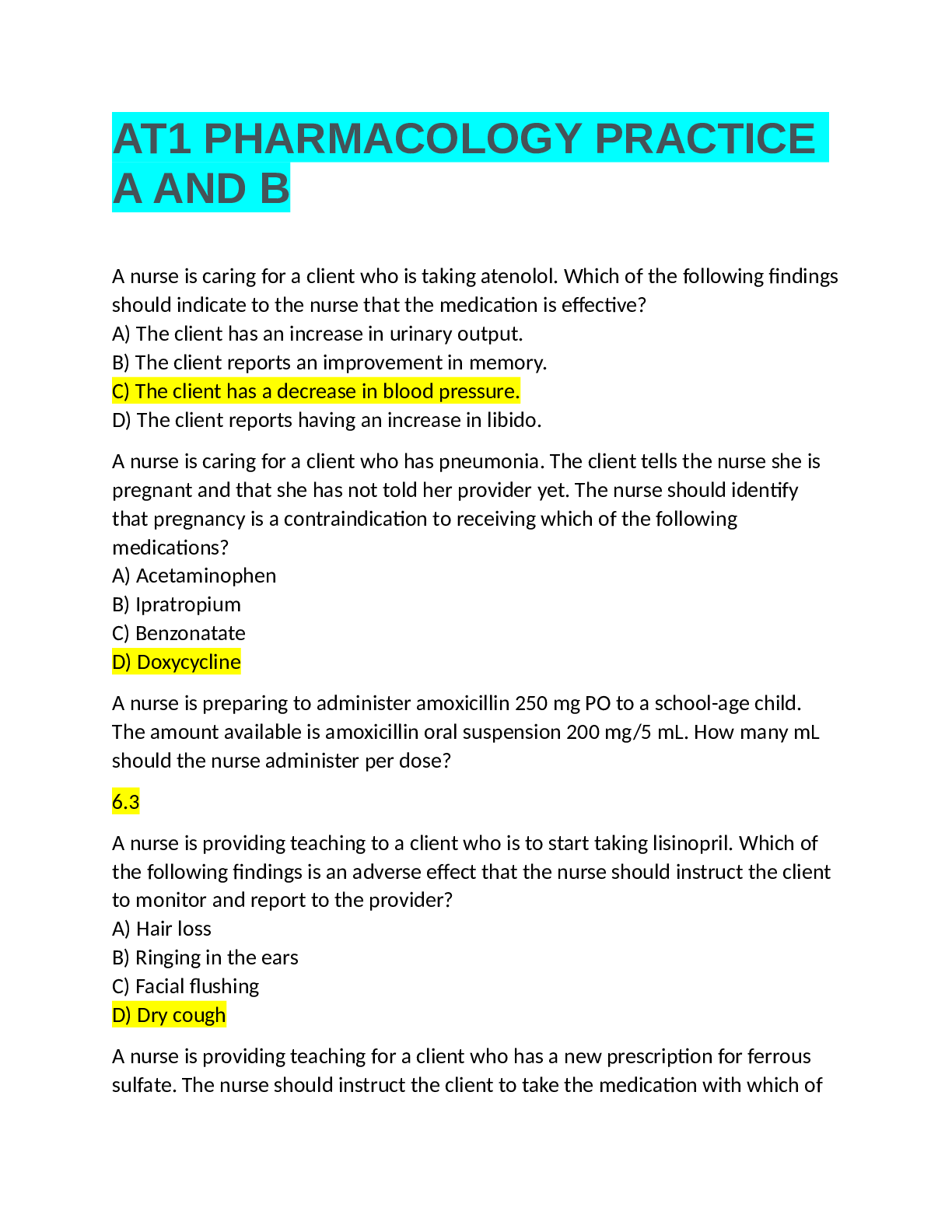
.png)
.png)
.png)
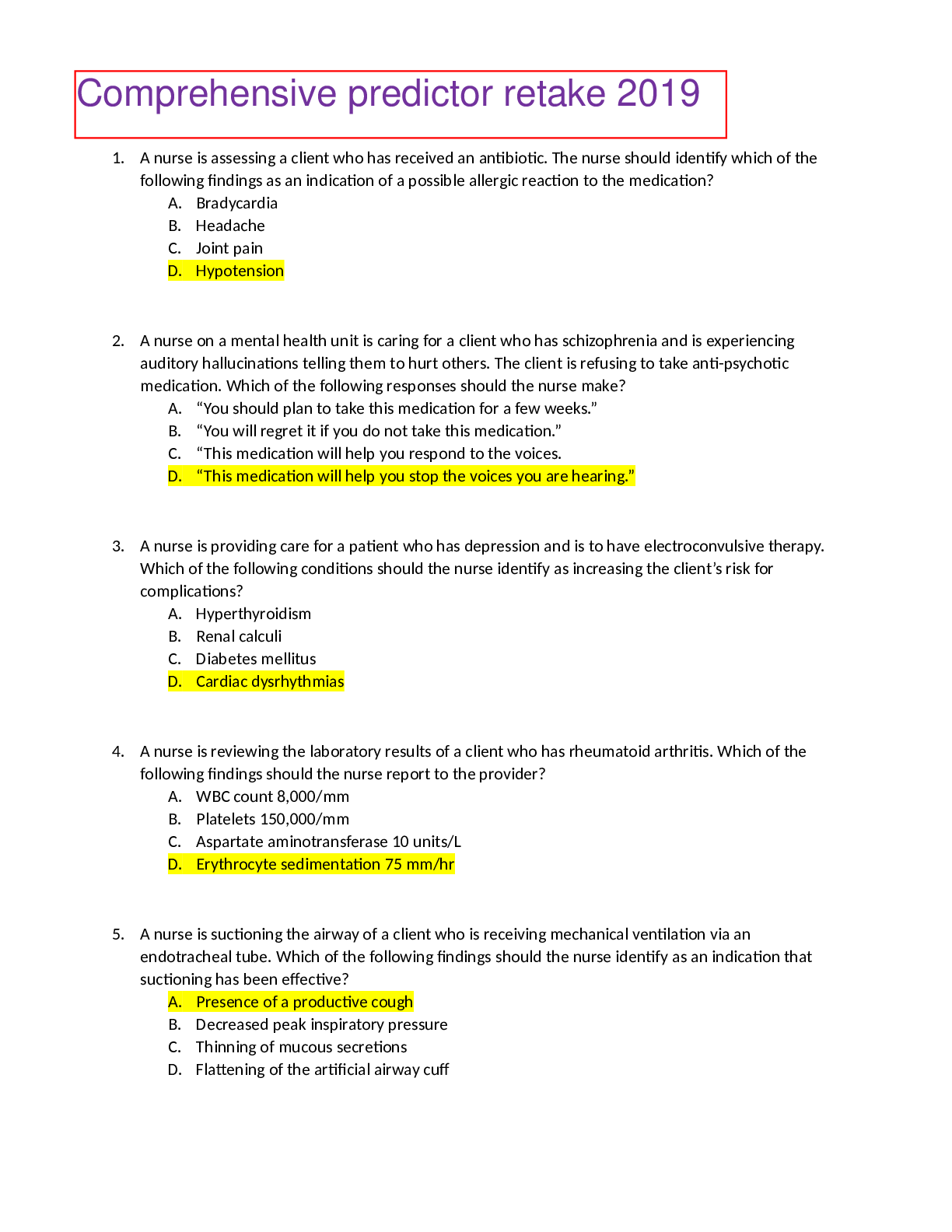
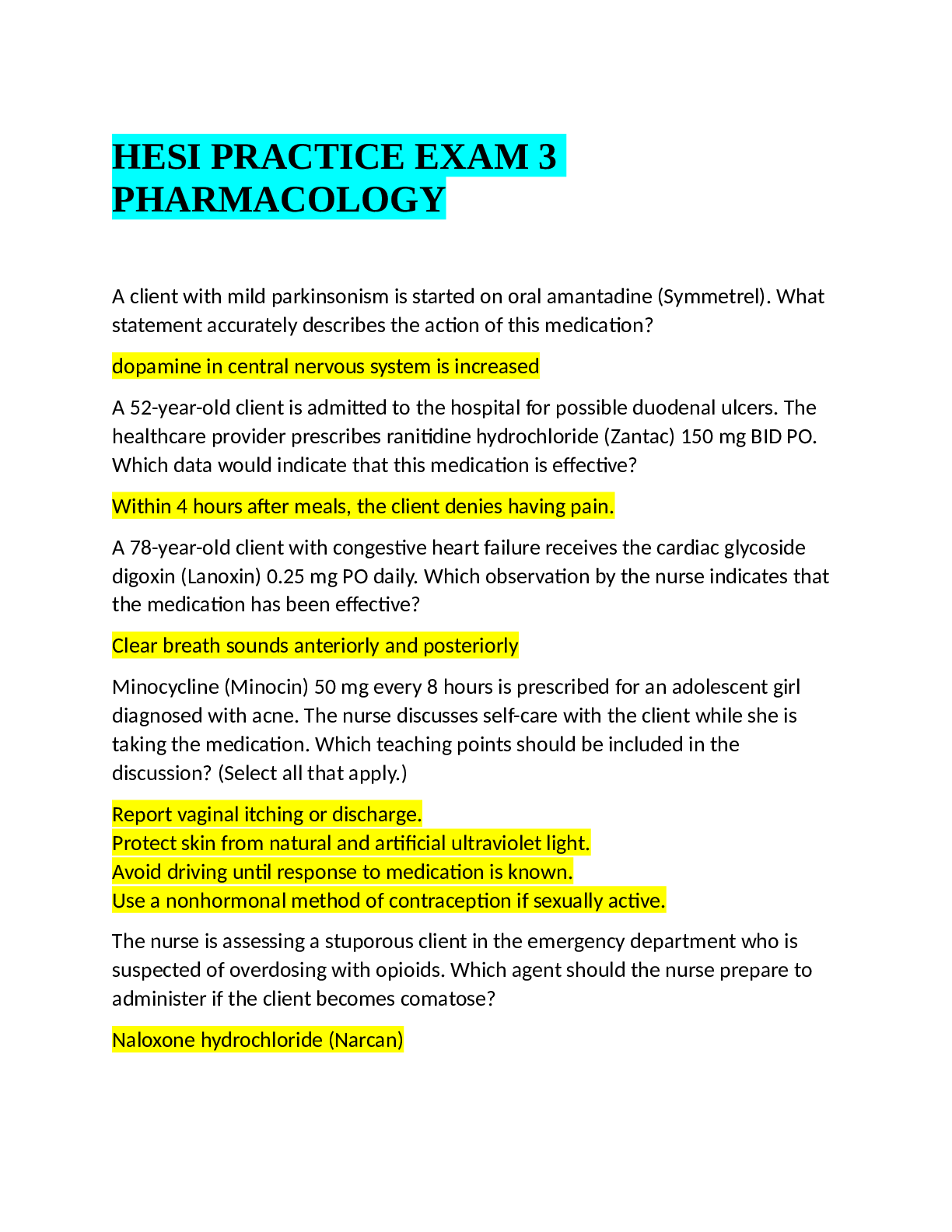
.png)
 (1).png)
